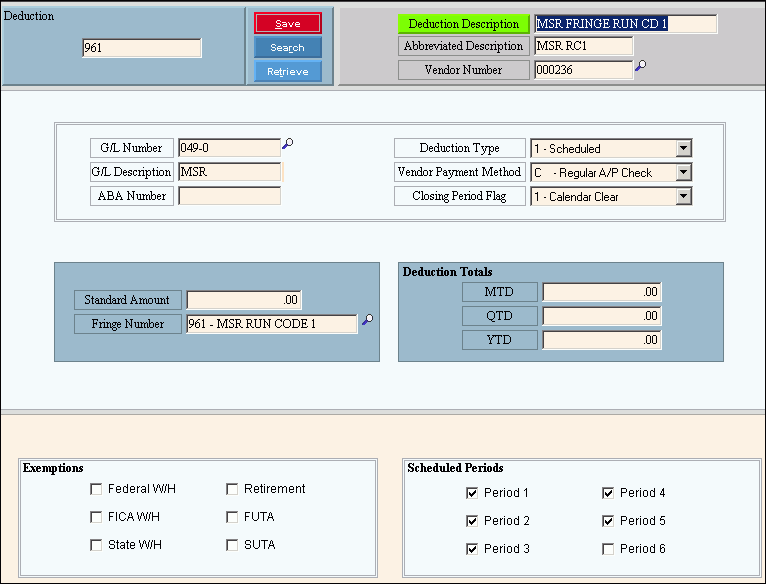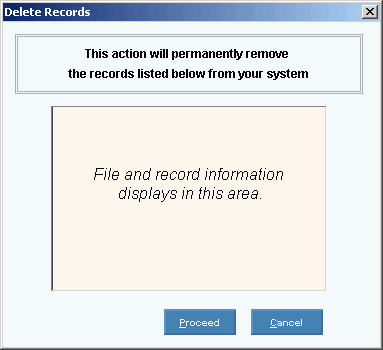Opening Deduction Master Maintenance, click More.
1. Click Payroll from the Menu Bar.
2. Click Miscellaneous File Maintenance.
3. Click Deduction
Master.
Or, use the keyboard
shortcut: [ALT] [p]
[m] [d].
Deduction Master Maintenance Window Example:

Creating a new Deduction Code, click More.
To create a new deduction:
Deduction Master Maintenance Prompts Tip: To see more information about a field, click the hyperlink for the field name. |
|
Enter the new Deduction
Code and click Retrieve
Required Tips: To indicate that you are building
a new Deduction Code, New
For a list of standard (reserved) Deduction Codes, see the Standard Fringe Numbers and Deduction Codes topic. |
|
|
To update the new or changed information click Save or press [ENTER]. Keyboard shortcut: [ALT + s] |
To avoid losing data, you must save new or changed deductions. |
|
|
You can use Search to view all of the existing deductions. From the Search list you can select a deduction to change or delete. Keyboard shortcut: [ALT + r] |
|
To display an existing deduction, enter the Deduction Code and click Retrieve or press [ENTER]. Keyboard shortcut: [ALT + t] |
Enter an informative description of the deduction. (up to 20 characters) |
|
Enter the abbreviated description. (up to 8 characters) |
|
Enter the Vendor Number. (up to 6 characters) Tips:
|
|
Enter the General Ledger Account Number, if applicable. Tips:
|
|
Enter the text to appear in the General Ledger journal entry, if applicable. (up to 12 characters) Tip: This description prints with the General Ledger Account Number on the Payroll Post Reports - Post to G/L Journal. |
|
Enter the American Banking Association number for the financial institution that will receive the direct deposit for this deduction, if applicable. (up to 10 characters) |
|
Click one of the following the Deduction Types in the drop-down list:
|
|
Click one of the following the Vendor Payment Methods in the drop-down list:
|
|
To specify when deduction totals should be cleared, click one of the following the Deduction Closing Period Flags in the drop-down list:
|
|
Enter the standard deduction amount that appears in deductions assigned to employees during Employee Master Maintenance in the Employee Master Scheduled Deductions Area. You can override this value. (4.2 numeric) Tip: If the value for this deduction is different for most employees, leave this value blank. |
|
Enter the Fringe Number to be updated when the Payroll Post processes transactions for this Deduction Code for the employer share or matching deduction. You can use the same Fringe # as the Deduction # for simplicity, but it's not required. (3.0 numeric) Important: Do not enter a Fringe number if this deduction is only for the employee portion with no employer paid portion. Tip:
To Search
for a Fringe Number, click Search
Keyboard shortcut: [CTRL + f] |
|
Displays the total deduction amount accumulated during the current month for all employees. (7.2 numeric) Tip: This field is updated by the Payroll Post, so under normal conditions you do not need to edit the value. |
|
Displays the total deduction amount accumulated during the current quarter for all employees. (7.2 numeric) Tip: This field is updated by the Payroll Post, so under normal conditions you do not need to edit the value. |
|
Displays the total deduction amount accumulated during the current year for all employees. (7.2 numeric) Tip: This field is updated by the Payroll Post, so under normal conditions you do not need to edit the value. |
|
To specify which withholding exemptions apply to this deduction (if any), select or de-select the box next to the type of exemption. Exemptions:
Note: If Payroll has accumulated Deduction Amount Totals, do not change the exemption selections until after the Period End Clear for the year. |
|
To specify which Scheduled Periods apply to this Deduction Code, select or de-select the box next to each of the six Scheduled Periods. Tip: These standard periods appear in deductions assigned to employees during Employee Master Maintenance in the Employee Scheduled Deductions Area. You can override the periods for individual employees. |
|
Editing an existing Deduction Code, click More.
![]() CAUTION:
To avoid losing data, you must save new or changed deductions.
CAUTION:
To avoid losing data, you must save new or changed deductions.
To display the record to be changed, enter the Deduction Code and click Retrieve
 or press
[ENTER].
or press
[ENTER].
Keyboard shortcut: [ALT + t]
Tip: If you do not know the Deduction Code, you can click Search to see a list of deductions.
to see a list of deductions.
To position the pointer to the information that you want to change, press [TAB] or click the field using the mouse.
Enter the data changes.
To complete the edit process, click Save
 or press [ENTER].
or press [ENTER].
Keyboard shortcut: [ALT + s]
Deleting a Deduction Code, click More.
![]() Warning: You
can not delete a Deduction
Code if it has been assigned to an employee during Employee Master
Maintenance in the Employee
Master Scheduled Deductions Area.
Warning: You
can not delete a Deduction
Code if it has been assigned to an employee during Employee Master
Maintenance in the Employee
Master Scheduled Deductions Area.
To display the record to be deleted, enter the Deduction Code and click Retrieve
 or press
[ENTER].
or press
[ENTER].
Keyboard shortcut: [ALT + t]
Tip: If you do not know the Deduction Code, you can click Search to see a list of deductions.
to see a list of deductions.
Click File from the Menu Bar, and next click Delete.
Keyboard shortcut: [ALT] [f] [d]At the Delete Records prompt, click Proceed to delete the record, or click Cancel to escape from the delete routine.
Example:

Note: After you click Proceed, you will see the following message on the Status Bar.
